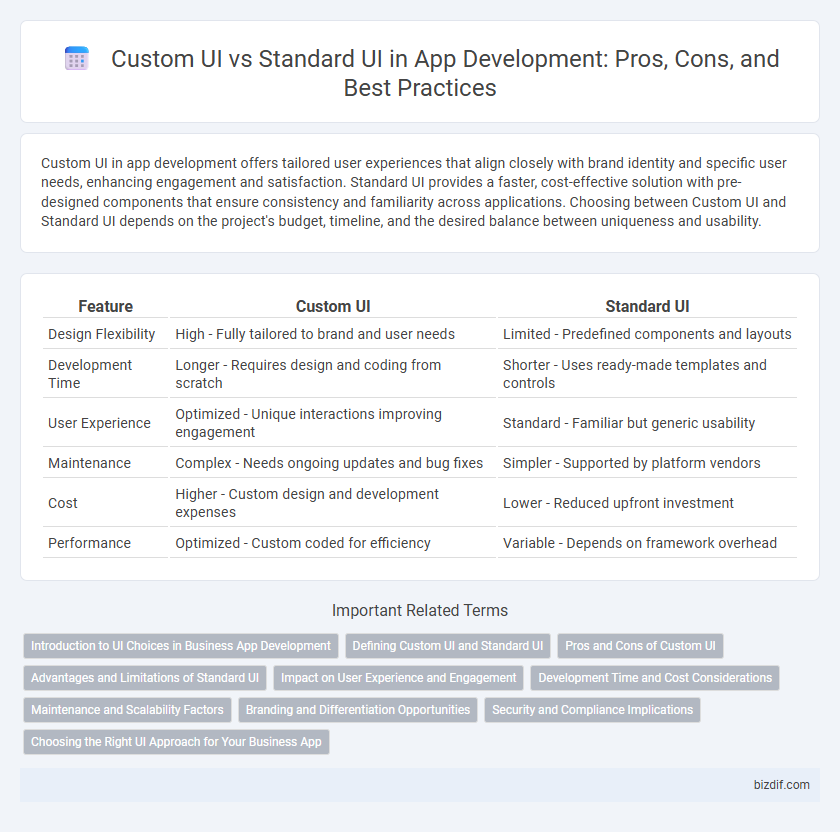Custom UI in app development offers tailored user experiences that align closely with brand identity and specific user needs, enhancing engagement and satisfaction. Standard UI provides a faster, cost-effective solution with pre-designed components that ensure consistency and familiarity across applications. Choosing between Custom UI and Standard UI depends on the project's budget, timeline, and the desired balance between uniqueness and usability.
Table of Comparison
| Feature | Custom UI | Standard UI |
|---|---|---|
| Design Flexibility | High - Fully tailored to brand and user needs | Limited - Predefined components and layouts |
| Development Time | Longer - Requires design and coding from scratch | Shorter - Uses ready-made templates and controls |
| User Experience | Optimized - Unique interactions improving engagement | Standard - Familiar but generic usability |
| Maintenance | Complex - Needs ongoing updates and bug fixes | Simpler - Supported by platform vendors |
| Cost | Higher - Custom design and development expenses | Lower - Reduced upfront investment |
| Performance | Optimized - Custom coded for efficiency | Variable - Depends on framework overhead |
Introduction to UI Choices in Business App Development
Custom UI in business app development enables tailored interfaces that align closely with specific brand identities and user workflows, enhancing user engagement and operational efficiency. Standard UI offers pre-built components and design templates that expedite development and reduce costs while ensuring consistency and reliability across different platforms. Choosing the right UI approach depends on project requirements, budget constraints, and the desired balance between uniqueness and speed to market.
Defining Custom UI and Standard UI
Custom UI in app development involves designing unique user interfaces tailored to specific brand identities and user experiences, allowing for greater flexibility and differentiation. Standard UI refers to pre-built interface components and templates provided by frameworks or platforms, enabling faster development and consistent usability. Choosing between Custom UI and Standard UI impacts the app's performance, user engagement, and development timeline.
Pros and Cons of Custom UI
Custom UI offers unique and tailored user experiences that align closely with brand identity, enhancing user engagement and satisfaction. However, developing a Custom UI requires more time, higher costs, and increased maintenance complexity compared to Standard UI frameworks. The flexibility of Custom UI enables innovative features but demands specialized design and development expertise.
Advantages and Limitations of Standard UI
Standard UI offers faster development and consistent user experience by utilizing pre-built components optimized for common tasks. Its limitations include reduced flexibility in design customization and potential constraints in meeting specific branding or functional requirements. This can impact the uniqueness and adaptability of the app interface for specialized user interactions.
Impact on User Experience and Engagement
Custom UI in app development enhances user experience by providing tailored interfaces that align closely with brand identity and user preferences, resulting in higher engagement and satisfaction. Standard UI offers consistency and familiarity, which can reduce learning curves but may limit differentiation and user connection. Choosing Custom UI drives stronger emotional engagement through unique, intuitive interactions, while Standard UI emphasizes reliability and ease of use.
Development Time and Cost Considerations
Custom UI development often requires more time and higher costs due to the need for unique design, coding, and testing tailored to specific user preferences. Standard UI frameworks provide pre-built components that significantly reduce development time and lower expenses by leveraging reusable elements and established design guidelines. Choosing between custom and standard UI depends on budget constraints and project timelines, with custom solutions offering greater flexibility at a premium cost.
Maintenance and Scalability Factors
Custom UI offers greater flexibility for maintenance by allowing developers to address specific user needs and update components independently, enhancing scalability for complex applications. Standard UI frameworks provide ease of maintenance through pre-built elements and consistent design patterns, but may limit customization and slow scalability in unique or feature-rich apps. Prioritizing Custom UI benefits businesses requiring tailored experiences and rapid adaptation, while Standard UI suits projects valuing faster deployment and uniformity.
Branding and Differentiation Opportunities
Custom UI offers extensive branding and differentiation opportunities by enabling unique visual elements, tailored interactions, and personalized user experiences that align closely with a brand's identity. Standard UI components, while easier to implement, often result in generic interfaces that limit distinctiveness and reduce competitive advantage in crowded app markets. Investing in Custom UI development enhances brand recognition and user loyalty through consistent and memorable design features.
Security and Compliance Implications
Custom UI offers enhanced security controls tailored to specific compliance frameworks like GDPR and HIPAA by enabling developers to implement strict access controls and data encryption protocols. Standard UI solutions often rely on generic security measures, which may not fully address industry-specific regulatory requirements, potentially increasing vulnerability to data breaches. Choosing a custom UI ensures greater flexibility in meeting rigorous security audits and maintaining regulatory compliance throughout the app development lifecycle.
Choosing the Right UI Approach for Your Business App
Selecting the right UI approach for your business app involves evaluating Custom UI and Standard UI based on flexibility, development time, and user experience. Custom UI offers tailored design and functionality to align with specific brand identity but requires more resources and longer development cycles. Standard UI provides faster deployment and consistency through pre-built components, ideal for projects prioritizing efficiency and reduced complexity.
Custom UI vs Standard UI Infographic

 bizdif.com
bizdif.com